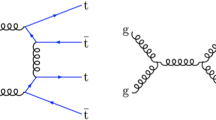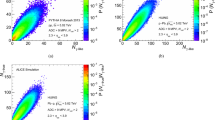Abstract
The fragmentation fractions of \(c\) and \(b\) quarks into the weakly decaying charmed hadrons \(D^{0}\), \(D^+\), \(D_s^+\) and \(\Lambda _c^+\), and into the charmed vector meson \(D^{*+}\) have been derived from the LEP measurements and averaged. The \(c\) quark fragmentation fractions represent probabilities to hadronise as a given charmed hadron, while the \(b\) quark fragmentation fractions are defined as sums of probabilities to produce a particular charmed hadron or its antiparticle.
Similar content being viewed by others
1 Introduction
Charmed mesons are produced in processes of charm quark fragmentation and in decays of bottom hadrons. The large values of the \(c\) and \(b\) quark masses allow using the perturbative QCD (pQCD) calculations for describing the heavy quark production. However, to describe completely the heavy quark transition into a given hadron, a non-perturbative parametrisation tuned to experimental results is needed. Fragmentation functions, used to parametrise a transfer of quark’s energy to a given hadron, are expected to be rather different for different pQCD calculations [1–3]. Fragmentation fractions are probabilities for \(c/b\) quark to hadronise as a particular charmed/bottom hadron, \(f(c\rightarrow H_c)\)/\(f(b\rightarrow H_b)\). The fragmentation fractions of \(b\) quark to a particular charmed hadron, \(f(b\rightarrow H_c)\), can be defined similarly representing convolutions of the \(f(b\rightarrow H_b)\) fractions and branching fractions of the bottom hadrons into a given charmed hadron. For heavy quark (\(Q\)) production at large energies far from the \(Q{\bar{Q}}\) threshold, the fragmentation fractions are often assumed to be universal.
Charm and bottom quark production in \(e^+e^-\) annihilations provides the cleanest environment for the heavy quark fragmentation measurements. A compilation of charm fragmentation fractions was performed in 1999 [4] using available at that time published and preliminary LEP measurements in \(Z\) decays as well as the results obtained at centre-of-mass energies of about \(10\) GeV. In this article, the fragmentation fractions of \(c\) and \(b\) quarks into the weakly decaying charmed hadrons \(D^{0}\), \(D^+\), \(D_s^+\) and \(\Lambda _c^+\), and into the charmed vector meson \(D^{*+}\), derived from the final LEP results, are presented. The measurements at centre-of-mass energies of \({\sim }10\) GeV are not included in this compilation because they can be affected by exclusive production channels, such as \(e^+e^- \rightarrow D^{(*)+}D^{(*)-}\) [5], and threshold effects.
The LEP measurements, used in this article, were based on the charmed hadron decays summarised in Table 1. Results of all measurements have been updated using new branching fractions of the above decays. For all decays, except \( {\Lambda _c^+}\,{\rightarrow }\, p~K^{-}~\pi ^{+} \), the current world average values [6] of the branching fractions are used. For the \( {\Lambda _c^+}\,{\rightarrow }\, p~K^{-}~\pi ^{+} \) decay, the branching fraction determination in Ref. [6] is model dependent resulting in the value \(\mathcal B( {\Lambda _c^+}\,{\rightarrow }\, p~K^{-}~\pi ^{+} ) = (5.0\pm 1.3)\,\%\) with the large uncertainty originating from the model dependence. In this article, the branching fraction obtained as the weighted mean of the BELLE [7] and CLEO [8] measurements is used for the \( {\Lambda _c^+}\,{\rightarrow }\, p~K^{-}~\pi ^{+} \) decay. The \(b\) quark fragmentation fractions are defined as sums of probabilities to produce a particular charmed hadron or its antiparticle.
2 Charm fragmentation fractions
Production rates of charmed hadrons \(D^{0}\), \(D^+\), \(D_s^+\) and \(\Lambda _c^+\) in \(Z\rightarrow c{\bar{c}}\) were reported by the ALEPH [9], DELPHI [10] and OPAL [11] collaborations in the form of product \(R_c \cdot f(c\,{\rightarrow }\, H_c) \cdot \mathcal B\), where \(R_c=\Gamma (Z\rightarrow c{\bar{c}})/\Gamma (Z\rightarrow \mathrm{hadrons})\) and \(\mathcal B\) is the branching fraction of the corresponding charmed hadron decay. For \(D^{*+}\) meson, the products were published by DELPHI [10] and OPAL [12] (the ALEPH direct measurement of \(f(c \,{\rightarrow }\, D^{*+})\) is described below). The measurements are collected in Table 2. The DELPHI and OPAL rates for \(D_s^+\) were corrected for the branching fraction \(\mathcal B(\phi \rightarrow K^+K^-)\). The OPAL result for \(D_s^+\), obtained using decay channels \(D_s^+\rightarrow \phi \pi ^+\) and \(D_s^+\rightarrow \bar{K}^{*0} K^+\), was expressed in terms of the decay \(D_s^+\rightarrow \phi \pi ^+\) with the uncertainty of the ratio of the two branching fractions included into a systematic uncertainty.
Charm fragmentation fractions are obtained by dividing the measured \(R_c \cdot f(c\,{\rightarrow }\, H_c) \cdot \mathcal B\) values from Table 2 by the relevant branching fractions [6–8] and the Standard Model (SM) value \(R_c=0.1723\) [13]. The ALEPH measurement of \(D^{*+}\) production rate in \(Z\rightarrow c{\bar{c}}\) [9], reported as
is updated using the latest values of the \(\mathcal B(D^{*+}\rightarrow D^0\pi ^+)\) and \(\mathcal B(D^0\rightarrow K^-\pi ^+)\) branching fractions [6].
The double-tag measurements of the product \(f(c\rightarrow D^{*+}) \cdot \mathcal B(D^{*+}\rightarrow D^{0}\pi ^+)\) were performed by DELPHI [14] and OPAL [12]. The double-tag method, based on tagging of one heavy quark and detection of a low momentum charged pion from the \(D^{*+}\rightarrow D^{0}\pi ^+\) decay in the hemisphere opposite to the tagged quark, substantially reduces backgrounds, although at the price of reduced statistics. The \(f(c \,{\rightarrow }\, D^{*+})\) values derived from the product by DELPHI,
and by OPAL,
are updated using the latest value of the \(\mathcal B(D^{*+}\rightarrow D^0\pi ^+)\) branching fraction [6].
Charm fragmentation fractions derived from the LEP measurements are collected in Table 3.
3 Bottom fragmentation fractions
Production rates of charmed hadrons \(D^{0}\), \(D^+\), \(D_s^+\) and \(\Lambda _c^+\) in \(Z\rightarrow b{\bar{b}}\) were measured by ALEPH [15], DELPHI [10] and OPAL [11]. The ALEPH collaboration converted the measured rates into the bottom fragmentation fractions, while the DELPHI and OPAL measurements were reported in the form of product \(R_b \cdot f(b\,{\rightarrow }\, H_c) \cdot \mathcal B\), where \(R_b=\Gamma (Z\rightarrow b{\bar{b}})/\Gamma (Z\rightarrow \mathrm{hadrons})\) and \(\mathcal B\) is the branching fraction of the corresponding charmed hadron decay. For \(D^{*+}\) meson, the products were published by DELPHI [10] and OPAL [12]. The measurements are collected in Table 4. The DELPHI and OPAL rates for \(D_s^+\) were corrected for the branching fraction \(\mathcal B(\phi \rightarrow K^+K^-)\). The OPAL result for \(D_s^+\), obtained using decay channels \(D_s^+\rightarrow \phi \pi ^+\) and \(D_s^+\rightarrow \bar{K}^{*0} K^+\), was expressed in terms of the decay \(D_s^+\rightarrow \phi \pi ^+\) with the uncertainty of the ratio of the two branching fractions included into a systematic uncertainty.
The \(f(b\rightarrow H_c)\) values measured by ALEPH are updated using the latest values of the relevant branching fractions [6–8]. For DELPHI and OPAL, the bottom fragmentation fractions are obtained by dividing the measured \(R_b \cdot f(b\,{\rightarrow }\, H_c) \cdot \mathcal B\) values from Table 4 by the relevant branching fractions [6–8] and the SM value \(R_b=0.21579\) [13].
The double-tag measurement of the product \(f(b\rightarrow D^{*+}) \cdot \mathcal B(D^{*+}\rightarrow D^{0}\pi ^+)\) was performed by OPAL [12]. The \(f(b \,{\rightarrow }\, D^{*+})\) value derived from the product,
is updated using the latest value of the \(\mathcal B(D^{*+}\rightarrow D^0\pi ^+)\) branching fraction [6].
Bottom fragmentation fractions derived from the LEP measurements are collected in Table 5. In Ref. [9], ALEPH reported the ratio
Using the ratio, the \(f(c\rightarrow D^{*+})\) value derived from the ALEPH \(D^{*+}\) rate measurement, and the SM values of \(R_c\) and \(R_b\) gives \(f(b\rightarrow D^{*+})=21.4\,\%\) in general agreement with other results. However, this estimate is not included in the calculation of the LEP average values because there is not enough information in Ref. [9] for evaluation of its uncertainties.
4 Average LEP fragmentation fractions
For each fragmentation fraction considered, the results are averaged using a standard weighted least-squares procedure [6]. The statistical and systematic uncertainties are added in quadrature and the combined uncertainties are used. For \(D^{0}\) and \(D^+\) from OPAL, the systematic uncertainties are slightly asymmetric and the uncertainty with a larger absolute value is used. The systematic uncertainties related to the detector description, signal-extraction procedure and Monte Carlo statistics are assumed to be uncorrelated between the LEP experiments. The uncertainties related to the modelling of \(Z\rightarrow c{\bar{c}}\) and \(Z\rightarrow b{\bar{b}}\) events are taken as the correlated uncertainties. Taking the correlations into account produces small but visible effects on the resulting values and their combined uncertainties.
Average values of the charm and bottom fragmentation fractions into charmed hadrons, derived from the LEP measurements, are collected in Table 6. The sum of the average \(f(c\rightarrow H_c)\) fragmentation fractions into the weakly decaying charmed hadrons \(D^{0}\), \(D^+\), \(D_s^+\) and \(\Lambda _c^+\) is
leaving a large room for the fragmentation of a charm quark into \(\Xi _c^+\), \(\Xi _c^0\) and \(\Omega _c^0\) baryons. The sum of the average \(f(b\rightarrow H_c)\) fragmentation fractions into the weakly decaying charmed hadrons \(D^{0}\), \(D^+\), \(D_s^+\) and \(\Lambda _c^+\) is
reflecting the fact that more than one charm quark is produced on average in the hadronisation and decay of one bottom quark due to \(b\rightarrow c{\bar{c}}s\) processes. The sums uncertainties are calculated taking into account correlations between systematic uncertainties of the four fragmentation fractions in each measurement [9–11, 15].
5 Summary
The fragmentation fractions of \(c\) and \(b\) quarks into the weakly decaying charmed hadrons \(D^{0}\), \(D^+\), \(D_s^+\) and \(\Lambda _c^+\), and into the charmed vector meson \(D^{*+}\) have been derived from the LEP measurements and averaged. The \(b\) quark fragmentation fractions are defined as sums of probabilities to produce a particular charmed hadron or its antiparticle. The average values obtained are intended for normalisation of the non-perturbative component of charm and bottom hadronisation in analytic and Monte Carlo calculations.
References
M. Cacciari, On heavy quarks photoproduction and \(c\rightarrow D^*\) fragmentation functions. arXiv:hep-ph/9708282
J. Binnewies, B.A. Kniehl, G. Kramer, Predictions for \(D^{*\pm }\) photoproduction at DESY HERA with new fragmentation functions from CERN LEP 1. Phys. Rev. D 58, 014014 (1998). arXiv:hep-ph/9712482
P. Nason, C. Oleari, A phenomenological study of heavy-quark fragmentation functions in \(e^+e^{-}\) annihilation. Nucl. Phys. B 565, 245 (2000). arXiv:hep-ph/9903541
L. Gladilin, Charm hadron production fractions. arXiv:hep-ex/9912064
Belle collaboration, T. Uglov et al., Measurement of the \(e^+e^- \rightarrow D^{(*)+}D^{(*)-}\) cross sections. Phys. Rev. D 70, 071001 (2004). arXiv:hep-ex/04101038
K. A. Olive et al., Particle Data Group, The review of particle physics. Chin. Phys. C 38, 090001 (2014)
Belle collaboration, A. Zupanc et al., Measurement of the branching fraction \({\cal {B}}(\Lambda _c^+ \rightarrow pK^-\pi ^+)\). Phys. Rev. Lett. 113, 042002 (2014). arXiv:hep-ex/0004001
CLEO collaboration, D. E. Jaffe et al., Measurement of \({\cal {B}}(\Lambda _c^+\rightarrow pK^-\pi ^+)\). Phys. Rev. D 62, 072005 (2014). arXiv:1312.7826
ALEPH collaboration, R. Borate et al., Study of charm production in \(Z\) decays. Eur. Phys. J. C 16, 597 (2000). arXiv:hep-ex/9909032
DELPHI collaboration, P. Abreu et al., Measurements of the \(Z\) partial decay width into \(c{\bar{c}}\) and multiplicity of charm quarks per \(b\) decay. Eur. Phys. J. C 12, 225 (2000)
OPAL collaboration, G. Alexander et al., A study of charm hadron production in \(Z^0\rightarrow c{\bar{c}}\) and \(Z^0\rightarrow b{\bar{b}}\) decays at LEP. Z. Phys. C 72, 1 (1996)
OPAL collaboration, K. Ackerstaff et al., Measurement of \(f(c\rightarrow D^{*+}X)\) and \(f(b\rightarrow D^{*+}X)\) and \(\Gamma _{c{\bar{c}}}/\Gamma _{\rm had}\) using \(D^{*\pm }\) mesons. Eur. Phys. J. C 1, 439 (1998). arXiv:hep-ex/9708021
ALEPH, DELPHI, L3, OPAL collaborations and LEP electroweak working group, S. Schael et al., Electroweak measurements in electron–positron collisions at \(W\)-boson-pair energies at LEP. Phys. Rep. 532, 119 (2013). arXiv:1302.3415
DELPHI collaboration, P. Abreu et al., Determination of \(P(c\rightarrow D^{*+})\) and \(BR(c\rightarrow \ell ^+)\) at LEP 1. Eur. Phys. J. C 12, 209 (2000)
ALEPH collaboration, D. Buskulic et al., Charm counting in \(b\) decays. Phys. Lett. B 388, 648 (1996)
Author information
Authors and Affiliations
Corresponding author
Rights and permissions
Open Access This article is distributed under the terms of the Creative Commons Attribution License which permits any use, distribution, and reproduction in any medium, provided the original author(s) and the source are credited.
Funded by SCOAP3 / License Version CC BY 4.0.
About this article
Cite this article
Gladilin, L. Fragmentation fractions of \(c\) and \(b\) quarks into charmed hadrons at LEP. Eur. Phys. J. C 75, 19 (2015). https://doi.org/10.1140/epjc/s10052-014-3250-3
Received:
Accepted:
Published:
DOI: https://doi.org/10.1140/epjc/s10052-014-3250-3




